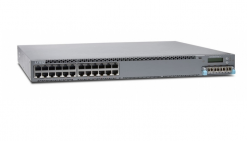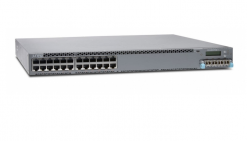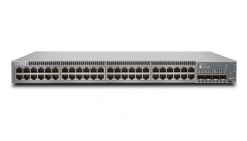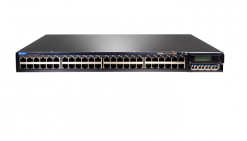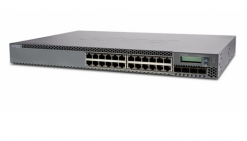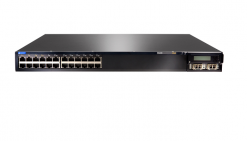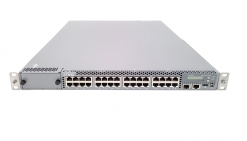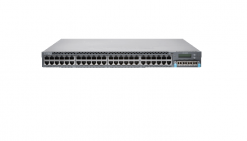Switch Juniper EX2300 24 Port Data, 4 SFP+ Uplink Slot
Liên hệ đặt hàng
Category: Switch Juniper
Tags: switch juniper, thiết bị chuyển mạch juniper, thiết bị mạng juniper
Thông số kỹ thuật Switch Juniper EX2300-24T
| Physical Specifications | |
| Dimensions (W x H x D) | – Width: – 17.4 in (44.19 cm) for desktop installations – 17.5 in (44.6 cm) with rack-mount brackets – Height: 1.75 in (4.45 cm) for 1U installations – Depth: 10.2 in (25.9 cm) |
| Backplane | – 80 Gbps Virtual Chassis interconnect to link up to four switches as a single logical device (EX2300-24/48T/P and EX2300-24MP models) – 120 Gbps Virtual Chassis interconnect to link up to six switches as a single logical device (EX2300-48MP) |
| Weight | 7.25 lb (3.29 kg) |
| Environmental Ranges | – Operating temperature: 32° to 113° F (0° to 45° C) – Storage temperature: -40° to 158° F (-40° to 70° C) – Operating altitude: up to 13,000 ft (3962 m) at 40° C according to GR-63 – Non-operating altitude: up to 15,000 ft (4572 m) – Relative humidity operating: 10% to 85% (noncondensing) – Relative humidity non-operating: 0% to 95% (noncondensing) |
| Hardware Specifications | |
| Switching Engine Model | Store and forward |
| DRAM | 2 GB |
| Flash | 2 GB |
| CPU | 1.25GHz ARM CPU |
| GbE port density per system | 28 (24 host ports + four-port SFP/ SFP+ uplinks) |
| Supported Optics | – 10/100/1000BASE-T connector type RJ-45 – GbE SFP optic/connector type: RJ-45, or LC SFP fiber supporting 1000BASE-T SFP, SX (multimode), LX (singlemode), or LH (single-mode) |
| Physical Layer | – Physical port redundancy: Redundant trunk group (RTG) – Cable diagnostics for detecting cable breaks and shorts – Auto MDI/MDIX (medium-dependent interface/mediumdependent interface crossover) support – Port speed downshift/setting maximum advertised speed on 10/100/1000BASE-T ports – Digital optical monitoring for optical ports |
| Packet Switching Capacities | 128 Gbps |
| Layer 2 Throughput (Mpps) | 95 Mpps (wire speed) |
| Layer 2 Switching | – Maximum MAC addresses in hardware: 16,000 – Jumbo frames: 9216 bytes – Number of VLANs supported: 4093 – Range of possible VLAN IDs: 1-4094 – Port-based VLAN – MAC-based VLAN – Voice VLAN – Layer 2 Tunneling Protocol (L2TP) – IEEE 802.1ak: Multiple VLAN Registration Protocol (MVRP) – Compatible with Per-VLAN Spanning Tree Plus (PVST+) – RVI (Routed VLAN Interface) – IEEE 802.1AB: Link Layer Discovery Protocol (LLDP) – LLDP-MED with VoIP integration – IEEE 802.1ad Q-in-Q tunneling – IEEE 802.1br: Bridge Port Extension – IEEE 802.1D: Spanning Tree Protocol – IEEE 802.1p: CoS Prioritization – IEEE 802.1Q: VLAN Tagging – IEEE 802.1Q-in-Q: VLAN Stacking – IEEE 802.1s: Multiple Spanning Tree Protocol (MSTP) – Number of MST instances supported: 64 – Number of VSTP instances supported: 253 – IEEE 802.1w: Rapid Spanning Tree Protocol (RSTP) – IEEE 802.1X: Port Access Control – IEEE 802.3: 10BASE-T – IEEE 802.3u: 100BASE-T – IEEE 802.3ab: 1000BASE-T – IEEE 802.3z: 1000BASE-X – IEEE 802.3ad: Link Aggregation Control Protocol (LACP) – IEEE 802.3x: Pause Frames/Flow Control |
| Layer 3 Features: IPv4 | – Maximum number of ARP entries: 1,500 – Maximum number of IPv4 unicast routes in hardware: 512 prefixes; 4,096 host routes – Maximum number of IPv4 multicast routes in hardware: 2,048 groups; 2,048 multicast routes – Routing Protocols: RIP v1/v2, OSPF v1/v2 – Static routing – Routing policy – Bidirectional Forwarding Detection (BFD) with slow timers (> 3 sec) – IP directed broadcast |
| Layer 3 Features: IPv6 Management Functionality | – Maximum number of Neighbor Discovery (ND) entries: 1,500 – Maximum number of IPv6 unicast routes in hardware: 512 prefixes; 2,048 host routes – Maximum number of IPv6 multicast routes in hardware: 1,024 groups; 1,024 multicast routes – Neighbor discovery, system logging, Telnet, SSH, SNMP, Network Time Protocol (NTP), Domain Name System (DNS) – Static routing – Routing protocols: RIPng, OSPF v3, Multica |






































